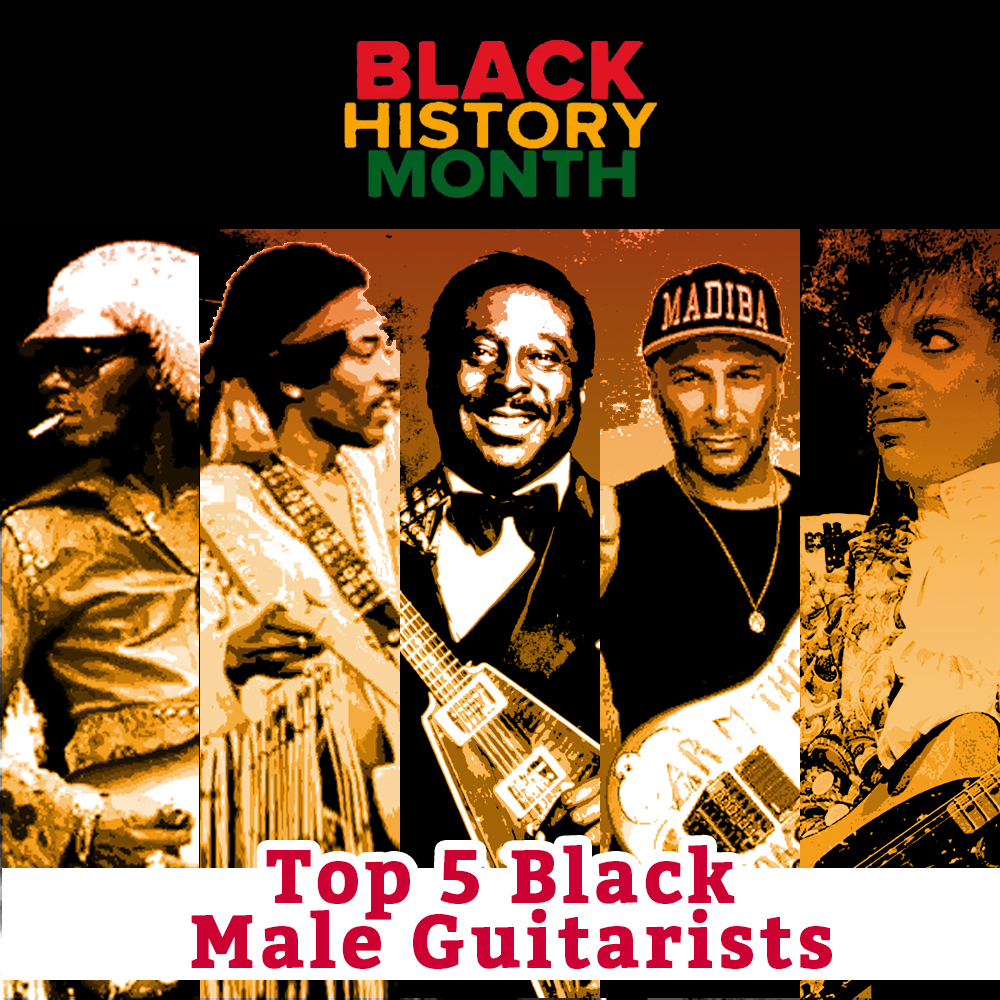
We are finishing up the celebration of Top Guitarists for Black History Month with a list of the top five black male guitarists. Yesterday we listed the top five black female guitarists.
Almost every top black male guitarist list is different. Some lists are based on technical skill, others are based on historical significance, and others are based on taste. Our list is unique. Our list is about innovation and in some ways underrated. We are going to skip the big three historical black guitarists (Chuck Berry, Robert Johnson, and B.B. King). Those are the top three on every list. Hopefully, our list might be a few you haven’t heard of.
Eddie Hazel
Born in Brooklyn in 1950, at the age of 17, he began to tour with George Clinton’s band The Parliaments. He started playing guitar when his brother bought him one for Christmas.
Eddie Hazel’s style can be described as R&B infused acid rock wrapped in funk. A style not too distant from Jimi Hendrix, but it was the added funk that made it Eddie’s music.
He is most known for the song Maggot Brain. George Clinton asked Eddie to think of the saddest thing he could think of and turn it into a guitar solo. Eddie Hazel drew inspiration from the passing of his mom and produced “Maggot Brain” in one take. Don’t let the title fool you, it is the most moving piece of guitar music you will ever hear.
Jimi Hendrix
Born in Seattle in 1942, Jimi Hendrix released his first single, “Hey Joe,” in 1967. Jimi didn’t get his first guitar, a five-dollar acoustic bought from his dad’s friend, until he was 16. A year later he got his first electric guitar.
Jimi’s style and innovation come from making music out of what traditionally was consider just noise and sound. The fuzz and feedback that were often avoided when playing the electric guitar, Hendrix embraced more than any other artist and infused it into the music. Creating new ground-breaking possibilities that are still used by guitarists today.
One of the greatest examples of Jimi Hendrix creating something new out of something familiar is his performance of The Star-Spangled Banner at Woodstock in 1969. The national anthem was a song everyone knew, but they never heard it on an electric guitar played by Jimi Hendrix. Although every song Hendrix played displayed innovation, the Star-Spangled Banner is one where even a layperson can hear what he is adding to the familiar tune.
Albert King
Born in 1923 in Indianola, Mississippi. He built his first guitar out of a cigar box. Keeping with them of innovative black guitarist, Albert King is a must on the list. Primarily known as one of the kings of blues. Multiple factors that lead to his groundbreaking style. First, he played the guitar upside down.
This automatically creates a different sound as you pull down on notes that others push up on. How can a difference of pushing and pulling on a string make a difference? When you are bending strings. String bending allows you to go through multiple notes, going through micro-tones and giving a vocal quality to them. There are three types of bends, full bends, half bends, and quarter bends. The first two are straightforward techniques, the last one, quarter bends, requires a little more skill, and Alan King’s Music was all about it.
Check out Albert Kin’s Bending notes below.
Tom Morello
Born in New York City in 1964. He joined his first band at the age of 13. It was a cover band called Nebula. Known for his role in the band Rage Against the Machine, he is one of the few guitarists that cites rap artists as some of his influences.
Tom Morello is a perfect example of an underrated innovator. His sound can be described as a lot of feedback noise, non-conventional picking and tapping, and heavy use of guitar effects. It may not be mainstream, but it is innovative and influence a new generation of guitar players over the last few decades. Two other additions that let you know you are listening to Morello on the guitar is sound manipulation, imitating sounds that you don’t expect to hear from a guitar and the kill switch. The kill switch instantly turns the guitar on and off. Check out an example of Morello using the Kill switch below.
Prince
He was born Prince Rogers Nelson on June 7, 1958, in Minneapolis, Minnesota. In high school, he started a band and only two years later in 1978 signed a deal with Warner Bros. Records.
Probably the most underrated guitarist of all time—only because he was talented in every form of music. You can say Prince not only innovated guitar but also revived it. In the ‘80s modern music was dominated by keyboards and drumbeats. Pop was mostly concerned with synthetic keyboards and rap was using synthesized drum machines. It was an electronic world as opposed to an electric one. Prince brought back the electricity and did it without apologies.
You can almost hear Prince announce the Electric Guitar is back in his hit single When Doves Cry. You can play the first four seconds below.
We did a full article on Prince. You can read it at Black History Month: Prince. We still think the best Guitar solo performance of all time is Prince playing While My Guitar Gently Weeps. In the performance below he comes in at the 3:29 mark, but you will want to watch the whole thing to see what happens when Prince comes in.
Who is The Next Great Guitar Innovator?
Prince began to learn the guitar when he was ten years old. At Rock Dojo we start kids as young as 6 and as old as 12. Rock Dojo is an award-winning guitar lesson system trusted by parents and kids. It is designed to help kids learn the guitar so fast they will be able to play and write their own songs by the time they get a Black Belt in rock!
To start your free lessons, add your name to our email list. Cancel anytime. Click the following link to learn more about our three free guitar lessons for kids.

